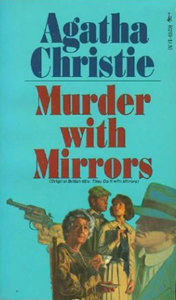In some midcentury novels, Agatha Christie tries totally new things (“Death Comes as the End” is set in ancient times; “The Hollow” puts complex characters ahead of the whodunit). In others she uses a standard formula but puts distinct themes atop it. “Murder with Mirrors” (1952, also published as “They Do It with Mirrors”) is one of this type.
Marple visits an old friend
Miss Marple visits an old childhood friend who is now the wife of a man who runs a rehabilitation college for psychologically troubled teen boys. When a murder of a board member takes place in the home near the dorms, Marple thinks about theatrical and magician trickery in working through whodunit.
Marple’s core lesson of “Don’t believe anything you haven’t verified for yourself” is on display more than ever before.

“Murder with Mirrors” (1952)
Also published as: “They Do It with Mirrors”
Author: Agatha Christie
Series: Miss Marple No. 5
Genre: Mystery
Setting: Stonygates, England, 1952
After this paragraph, I’m going to institute a spoiler warning to dig into the book’s core points. So let me say up front that I enjoyed the reading experience. “Murder with Mirrors” is a typically solid Christie book where I plow through the last 50 pages late at night rather than set it aside for tomorrow. But whether it survives a deeper critical analysis is another question.
(SPOILERS FOLLOW.)
Trickery
“Murder with Mirrors” – which refers to the notion of trickery via “smoke and mirrors” – engages in book-length sleight of hand. We’re introduced to the family tree of Marple’s friend Carrie Louise Serrocold. It’s so convoluted it borders on comical, requiring all of a reader’s focus to remember who is who. I paged back to the dramatis personae regularly.
I think the author is using this focus, along with our memories of how her previous books center on family feuds, to distract us. The solution to who killed Christian Gulbrandson in his guest room ends up having nothing to do with the family interplay.
Futhermore, Marple’s and Inspector Curry’s restaging of people’s positions in the grand hall on the night of the crime ends up not being relevant. But it inspires Marple to think in terms of theatrical staging (also a theme of the Poirot novel “Peril at End House”). She figures out that Carrie Louise’s husband Lewis Serrocold and his assistant Edgar Lawson had staged a verbal argument in Lewis’ office for everyone to hear.
Performance
This is straightforward enough; indeed, the author doesn’t hide the notion that the argument was likely staged as a distraction from the murder down the hallway. But then Christie asks us to make a huge leap: Lewis had run along the terrace to kill Christian during the argument. Everyone in the grand hall was hearing Edgar act out both roles: himself and Lewis.

This is the audio equivalent of the false masks that factor into many Christies, notably “13 at Dinner.” We can accept it so long as we don’t think too hard about it. But if you do think about it, it means Edgar has the ability to make his voice sound exactly like Lewis’. Remember, everyone is listening to this argument through the door very closely.
“Murder with Mirrors’ ” plausibility – and solvability — would’ve benefitted from Christie peppering in more clues. This is a rare case where the author does not trick a reader fair and square. Although she hints that the troubled Edgar has a theatrical flair to his behavior, Christie gives no information beforehand that suggests he is skilled at imitating voices.
I’ll be interested to watch the “Marple” TV episode of “Murder with Mirrors” to see how the actor pulls off the role of Edgar. He’ll have to act like someone who is good at acting, but not so good that we don’t suspect he’s acting. More challenging still, he’ll have to plausibly imitate the Lewis actor’s voice.
Motive
Speaking of implausibility, we have little chance of applying a possible motive to Lewis. It turns out he was embezzling money from his own institute, funneling it toward buying an island for psychological cases to set up a commune.
This twist is interesting in the way it illustrates Marple’s core lesson. Everyone had taken Lewis’ word that Christian visited the institute to discuss his fear that someone is poisoning Carrie Louise. In reality, Christian had found Lewis out and was discussing how to deal with this without upsetting Carrie Louise.
I admit I don’t know a lot about high-level finances, but Christie’s explanation of Lewis’ embezzlement is absurd. It doesn’t merely involve moving money, but illegally increasing the amount of money … somehow. Insider stock trading? It mostly consists of Marple poorly reiterating the situation and admitting she doesn’t understand the details herself.
There isn’t a page the novel that I didn’t enjoy reading. But Christie has shown she can do better than this on the details. So in the end, I have to say “Murder with Mirrors” is an unfair trick as much as it is a treat.
Every week, Sleuthing Sunday reviews an Agatha Christie book or adaptation. Click here to visit our Agatha Christie Zone.

